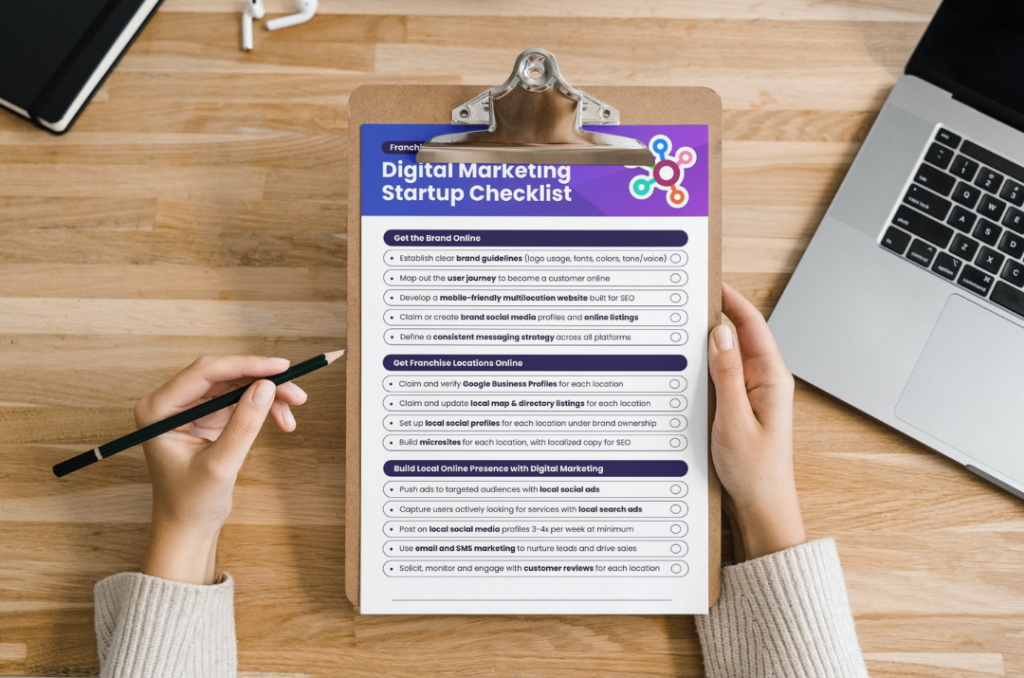Franchise marketing is all about consistency. Whether you’re grabbing a coffee at a franchise in Las Vegas, Baton Rouge, or Lansing, the experience should feel the same: familiar, high-quality, and aligned with the brand’s core values. But keeping everything aligned across locations—while still allowing each franchisee to market locally—is no small feat. That’s why we’ve put together The Franchise Marketing Success Checklist—a step-by-step guide to ensure your brand stays strong and scalable.

Laying the Groundwork: A Strong Brand Foundation
A strong foundation is the key to any successful franchise. Before you can scale a franchise, you need to ensure that every location—whether it’s the flagship store or a new location—is on the same page when it comes to brand messaging, visuals, and marketing strategies. This isn’t about stifling creativity—it’s about providing franchisees with the playbook they need to succeed, without having to reinvent the wheel.
By laying this groundwork, franchisees can spend more time growing their business and less time figuring out what works.
Why You Need a Franchise Marketing Checklist
Franchise success isn’t just about great products or services—it’s about consistency, visibility, and engagement. Without a solid marketing strategy, your franchise could face:
❌ A fragmented brand presence across locations
❌ Inconsistent customer experiences
❌ Missed opportunities in local search and digital advertising
❌ Poor communication between corporate and franchisees
With the right framework, you can avoid these pitfalls and set your brand up for long-term success.
Download The Checklist

From branding essentials to digital advertising, SEO, and ongoing optimization, this checklist ensures your franchise is set up for long-term growth. Download the checklist for a PDF on the go, or follow the steps below to start growing your brand.
Step 1: Get the Brand Online
Before any location can thrive, the brand itself needs to make a strong, consistent appearance online. Here’s what we recommend:
- Establish Clear Brand Guidelines: Define logo usage, fonts, colors, and tone/voice to keep things cohesive. Here’s a great guide from Canva with sample brand book templates to get you started.
- Map Out the User Journey: Ensure your customers have a smooth online experience from discovery to conversion. This will be important for the design of the website and the messaging of marketing campaigns.
- Develop a Mobile-Friendly, Multilocation Website: Your website needs to be optimized for SEO and mobile devices. Fun fact: over 60% of searches are now done on mobile devices, so don’t miss out on this key audience.
- Claim Social Media Profiles: Make sure all social platforms are claimed and active to engage with customers at all touchpoints.
- Messaging Strategy: Define consistent messaging across all platforms to keep the brand’s voice unified. Keep this information in a playbook for franchisees, vendors, and partners to follow.
Step 2: Get Franchise Locations Online
Once the brand is set up, the next step is ensuring each individual franchise location is represented online effectively.
- Claim and Verify Google Business Profiles: Google Business Profiles are crucial for local SEO. Franchise locations must claim and verify their profile to improve visibility. But that’s not all – it’s important to also optimize Google Business Profiles
- Update Local Listings: Keep local listings accurate and up-to-date on platforms like Yelp, Bing, and Apple Maps. Local listings drive 80% of location-based mobile searches, so getting this right is a must, especially for franchises managing local listings across the entire nation.
- Set Up Local Social Profiles: Give each location its own presence on social media under brand ownership. It’s local but still on-brand.
- Build Microsites: Microsites with localized content will help improve SEO performance and connect each location with its local audience. Debating if microsites should use subdomains or subfolders? Check out our recent blog post for tips.






Step 3: Build Local Online Presence with Digital Marketing
Here’s where the fun begins: digital marketing! Franchisees need to engage their local audience with targeted campaigns.
- Run Local Social Ads: Social ads can be laser-targeted to the right demographic. Use Facebook, Instagram, and even NextDoor or LinkedIn ads to push to a specific area. TikTok can also be a great tool to drive engagement, though its location targeting can be trickier than other channels for brands with multiple franchises in the same city.
- Target Active Searchers: Using local search ads on Google, you can capture users who are actively looking for services in their area. Coupled with search engine optimization, you can build long-term visibility and attract customers organically over time – SEO is the secret sauce for long-term growth.
- Post Regularly: Post on local social media profiles 3-4 times per week to keep customers engaged and informed. Social Media Management services can help locations supplement marketing on other channels.
- Email and SMS Marketing: Nurturing leads with SMS and email builds trust, keeps them engaged, and increases conversion chances by offering personalized, timely communication. These cost-effective, automated channels allow you to maintain long-term connections, ensuring your brand stays top-of-mind and driving customer loyalty.
- Engage with Customer Reviews: 83% of customers say they trust online reviews just as much as personal recommendations, so it’s important to respond to and engage with reviews consistently.
Step 4: Use Tools & Technology to Amplify Growth
Technology is your friend when it comes to managing multiple locations. Here’s how to set up systems that make marketing easier:
- Google Analytics: Set up tracking across your website and microsites to monitor performance and adjust strategies as needed.
- CRM Systems: A CRM helps franchisees track leads and customer interactions, making it easier to follow up and convert. At the very least, we recommend every business use a simple lead management tool to track the results of marketing beyond
- Content Calendar: Plan your content in advance and stay organized with a content calendar that aligns with your marketing goals.
- Review & Listing Management: Use an all-in-one tool to manage listings and customer reviews from one place.
- Rollup Dashboard: A rollup reporting dashboard gives you an easy-to-read snapshot of performance across all locations.
- Monthly Reporting: Stay on top of results and make data-driven decisions with regular reports to analyze what’s working and what’s not. Learn how to read marketing reports here.
Step 5: Level Up Your Brand’s Marketing
As your franchise grows, it’s important to continuously improve and optimize marketing efforts.
- Define Franchisee Support: Ensure that there are clear processes for supporting franchisees in their local marketing efforts.
- Set Tangible Goals: Setting measurable goals allows both corporate and franchisees to track progress and stay aligned.
- Partner with an Agency: Collaborating with a marketing agency or team ensures that your strategies are executed smoothly and effectively. Learn how to write an effective request for a proposal (RFP) from a digital marketing agency.
- Test and Repeat: Digital marketing is all about experimentation. Test different strategies, measure the results, and repeat the process for ongoing growth.
Conclusion
Digital marketing for franchises isn’t a one-size-fits-all solution. It requires a mix of consistent corporate oversight and localized flexibility to ensure every franchisee can succeed. At CyberMark, we partner with brands to provide the right strategies, tools, and support to help each location thrive while maintaining a unified brand experience.
Ready to elevate your franchise marketing game? Download our Franchise Marketing Success Checklist today and get started on the path to greater success!




